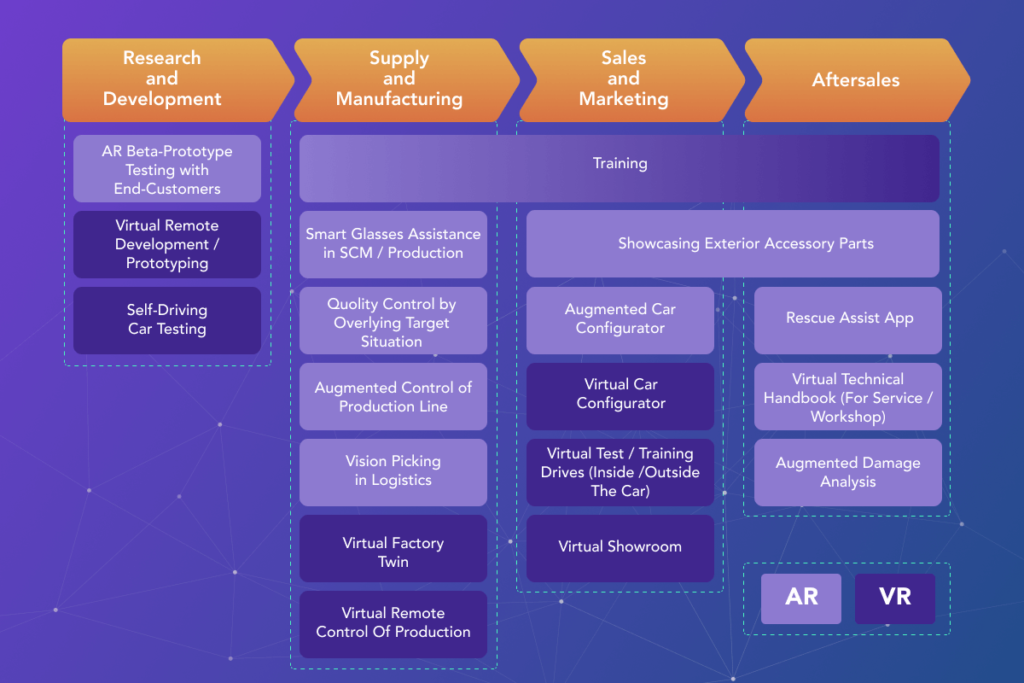Additional XR use cases in the automotive industry
But Extended Reality technologies are not only improving the customer experience, they are also able to improve different processes for the automaker throughout the whole value chain.

Design and Visual Prototyping
The design and development process in the automotive industry is continuously getting more expensive and also more time-consuming. VR-powered prototyping solutions enable the automakers to simulate different model variants and allow them to get a better view
of all systems and detect errors early in the process. This process also helps OEMs to reduce costs and accelerate development.
Although VR already offers a lot of possibilities, some automakers are still preferring real-life models of their cars to be able to see the different shapes, shadows and size-ratios better. Real model cars can also be used for visualizing different colors and models, by mapping digital projections onto the car.
Automakers like Mercedes and Volkswagen have already started using AR technology during the design and testing phase. Augmented Reality is also a lot better with visualizing proportions and sizes of different design and color variants of the vehicle
prototypes to better visualize the different proportions and sizes. Augmented Reality will also be used more and more during this process in the future.
Immersive Showrooms and Sales Experiences
If you are buying a car, you normally have to visit a car dealership. In the digital era, especially during the worldwide pandemic, customers do not need to visit the dealerships anymore. But with the development of immersive showrooms, they might want to do that anyway. VR-powered showrooms enable everybody to get a better feeling for their dream car. By using a VR headset, customers can see their future car in a 3D environment and browse through all the colors and additional equipment. By sitting on the right chair they could even take a virtual test drive. But this technology is not only great for customers, car dealerships can show their customers every variant of the model without the need of purchasing multiple cars for the showroom.
Training
XR applications can also help the employees to understand their working environment better and help them become more productive. Immersive technologies can also provide training for specific skills like welding and help them with avoiding dangerous situations at the production line. These training methods are also especially useful when the workers have to start building newly developed car models.
The same and additional training could also be relevant to employees in the after-sales and maintenance process. With future cars becoming more complex, car mechanics will also need different skills to repair these cars. AR training can help them with finding specific problems and solving them faster. Volkswagen already created a system called Marta for their VW XL 1 and Porsche launched the AR-powered Tech Live Look in 2017 and planned on distributing them to every dealership.
AR for Marketing and CGI
Augmented Reality is also used for creating images and videos for marketing purposes and showing the new models to the world. In the following video, Stephen Gray explains how General Motors is using AR for this purpose. (1:45 to 3:35)
Resources
https://www.allerin.com/blog/4-applications-of-ar-in-the-automotive-industry
https://blog.datamatics.com/9-ar-vr-use-cases-breaking-new-grounds-for-automotive-industry
https://techsee.me/blog/ar-automotive-technology/
https://www.toptal.com/virtual-reality/virtual-reality-in-the-automotive-industry
https://arvrjourney.com/developments-of-ar-that-will-change-the-automotive-industry-6021cb9c58a6
https://www.fiaformulae.com/en/news/2020/june/ar-vr
https://plat4m.com/future-of-ar-in-cars/?utm_source=medium&utm_medium=social&utm_campaign=ar
https://www.fiaformulae.com/en/news/2020/june/ar-vr
